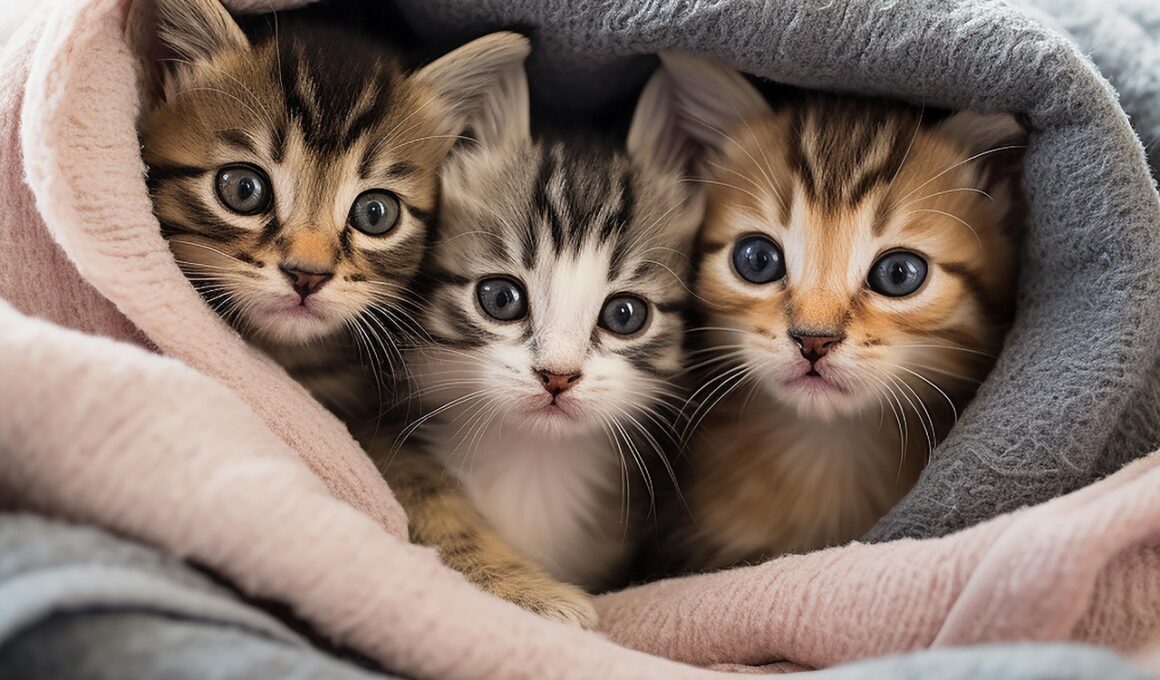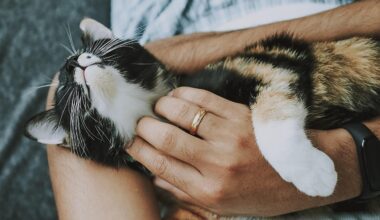Combining Play and Food Rewards for Effective Cat Socialization
Socializing your cat effectively is an essential aspect of responsible pet ownership. Understanding how to utilize food rewards alongside play can significantly enhance this process. Both play and food should be viewed as powerful tools for reinforcement. Encouraging a cat to engage with different people and environments can lead to a well-rounded personality. You can start by using interactive toys like feather wands or laser pointers. These play activities can help to foster bonding and trust. Moreover, during these play sessions, introduce treats to create a positive association in the cat’s mind. When a cat interacts successfully with new stimuli, that action deserves praise and reward. Gradually increase the complexity of the environments where socialization occurs, always keeping the positive reinforcement consistent. This method can help the cat learn that social interaction is fun and rewarding. Patience is crucial here; every cat learns at its own pace. Regular practice will lead to noticeable improvements in your cat’s social skills over time. Keeping sessions short yet engaging is key to sustaining your cat’s attention and interest throughout the learning process.
Understanding your cat’s body language can be beneficial for facilitating socialization. Recognizing signals of stress or discomfort can alert you when a cat may need a break. The comfort of your cat should remain a priority as you integrate new experiences. Place your cat in situations where they can explore without feeling cornered or threatened. Encouraging exploration can be done slowly; let the cat decide how much they want to engage or observe. If they approach new people calmly, offering a treat can reinforce that behavior. Conversely, if they show signs of fear, give them space and reduce the intensity of interaction. Use a soft voice and warm gestures to make them feel secure. A systematic approach will help your cat learn that social settings can be pleasant. Including various environments or visitors in the training can also be beneficial. Building up exposure over time can yield lasting results. Over time, your cat may demonstrate improved confidence and sociability overall. Play and food rewards together create a balanced method for elevating social skills. Thus, strengthening the bonds between your cat and family members or guests increases everyone’s enjoyment during interactions.
Integrating Play with Reward Systems
Another effective method in socializing your cat is integrating structured play with specific reward systems. Many pet owners find that both components work symbiotically to foster positive reinforcement. Start the training process by allowing the cat to engage in play freely, which will help them feel comfortable. During play, if the cat approaches a new person, it’s essential to reward that behavior with treats or praise. It creates a direct link between the social interaction and a positive outcome. For example, have a bag of treats handy while playing with the cat and distribute those small rewards as they exhibit socially acceptable behaviors. Additionally, timing is crucial; offering a treat right at the moment they engage encourages repetition. Make sure the treats offered are enticing enough; high-value snacks generally work better than regular kibble. You can also experiment with different toys to see what captures your cat’s attention. Through this combination of play and food rewards, you create an engaging learning environment that promotes socialization, ensuring your cat’s experiences are not just educational but also enjoyable. Consistent application of this strategy can pave the way for smoother interactions in future social situations.
Frequent practice in various settings is also key to a well-socialized cat. Gradually exposing your furry friend to new environments helps them build confidence and adaptability. Using food rewards makes these introductions much easier and more fun for your cat. The trick is to keep these experiences positive and not overwhelming. Consider inviting friends over after establishing a solid routine of play and food reinforcement at home. Let your cat explore these new faces at their own pace. Allowing them the freedom to choose their interactions helps alleviate stress. During these gatherings, utilize interactive toys to encourage engagement while simultaneously introducing treats. This can cultivate a positive atmosphere where your cat feels secure and curious. Additionally, try using different reward systems for varied settings. For instance, a soft treat may work great at home, while a favorite toy might work better in a more chaotic environment. Consistency in positive experiences leads to a better overall experience for the cat and those they interact with. By utilizing this approach, you will be well on your way to creating a sociable companion that enjoys interacting with others and exploring new environments enthusiastically.
Monitor Progress and Adjust Accordingly
Monitoring your cat’s progress during socialization sessions is crucial for understanding which techniques work best. Require being adaptable and observant; every cat has unique preferences and tolerances. Take notes on how your cat responds to different social situations, keeping track of positive and negative reactions. If a specific method or combination of play and food rewards seems effective, it’s wise to repeat it often. On the flip side, if your cat exhibits signs of stress during certain activities, make necessary adjustments immediately. Adjusting the environment, toy types, or even the timing of treats can make a world of difference in your cat’s comfort level. Offering them a favorite treat in a challenging situation may ease their anxiety. Regular evaluations allow you to tailor socialization strategies according to your cat’s development. Provide opportunities for them to socialize with other cats or friendly dogs, as real-life experiences further facilitate development. Always keep it engaging and fun, as stress should never be part of this vital process. Gradually, a well-socialized cat will become more relaxed and confident, enhancing both their lives and yours.
Consistency in training is fundamental when combining food rewards with playful activities. It’s worthwhile to adhere to a structured schedule, ensuring that your cat understands when social interaction will occur. Regularly set aside time for engaging play sessions that incorporate food rewards as a consistency anchor. For instance, set a daily routine where socialization becomes a predictable part of your cat’s day. Whether it’s playing with them alone or with others, ensure they look forward to these sessions. As your cat becomes more accustomed to these rewarding experiences, delight in noticing their increased willingness to engage with both new people and environments. Utilize different play modes such as fetch or pouncing games to maintain interest. Alter the treats you offer as well, keeping them intrigued and motivated. Frequent variation keeps social experiences fresh and fascinating. Ensure no two sessions feel identical, as your cat might lose motivation otherwise. Remember, the goal is to form positive associations, making social experiences enjoyable and less daunting for your cat. Finally, keep an eye on their overall mood during training—this will guide you to ensure that socialization becomes a source of pleasure for both pet and owner alike.
Conclusion
In conclusion, effective cat socialization hinges on the valuable combination of playful interaction and food rewards. Balancing these two aspects creates an enriching environment for the cat, crucial for success in social skills development. Throughout the various strategies discussed, ensure that patience and observation remain at the forefront of your training. Your cat will gradually become more comfortable and confident in social situations if you consistently offer encouragement paired with rewards. Remember to adapt and monitor accordingly; understanding your pet’s unique temperament will amplify the efficiency of your approach. Incorporating structured playtime, coupled with tasty treats, creates a positive feedback loop — cats learn that engaging with others can lead to happy outcomes. The process may take time, but both you and your cat will enjoy the adventures along the way. As confidence builds, delight in watching your cat flourish as an amiable companion to family and friends. With effective socialization techniques in practice, your pet can enjoy a fulfilling life, rich in positive interactions and connections with their environment and those around them. So embark on this journey with joy and commitment, as it leads to a wonderful bond with your feline friend.
Embarking on the socialization journey with your feline friend may seem daunting, but the rewards are undoubtedly worth it. Developing a method that pairs interaction with positive reinforcement can lead to a profound transformation in behavior. Every cat possesses their own personality; take the time to discover what energizes and excites your unique pet. By integrating play and food rewards into their training regimen, you not only foster strong social skills, but also deepen your bond. Remember, persistence is essential. As you implement these strategies, take note of your cat’s responses, adjusting your techniques according to their preferences. Celebrate the small victories: each successful interaction is a step towards a more confident and friendly cat. Gradual exposure to various environments and people will lead to long-lasting improvements. Pairing food rewards and engaging play sessions will establish a welcoming atmosphere for social interaction. Providing your pets with the tools they need to adapt to new situations offers a pathway toward a healthier, more fulfilling life. Keeping their mental and emotional well-being in mind ensures that each engagement remains a positive experience in their world. Your journey towards effective cat socialization starts today!


